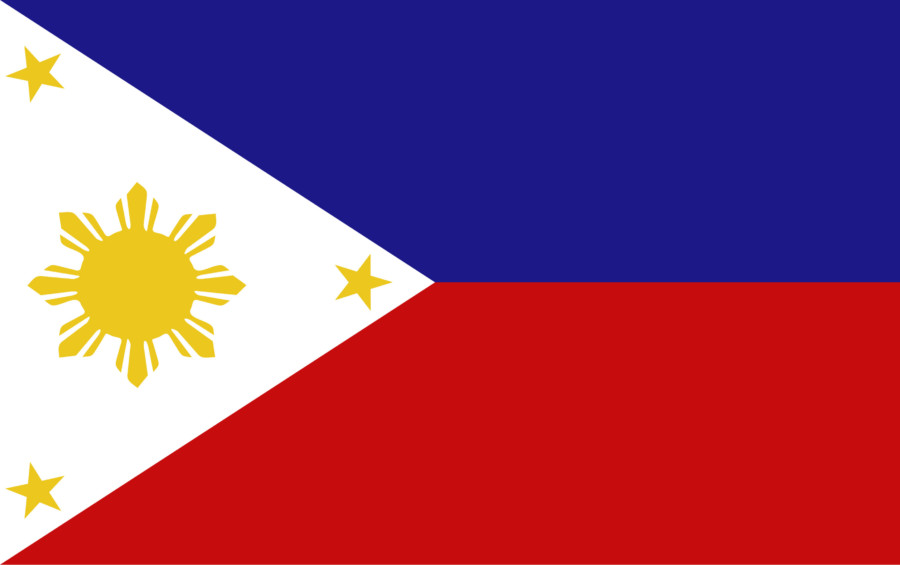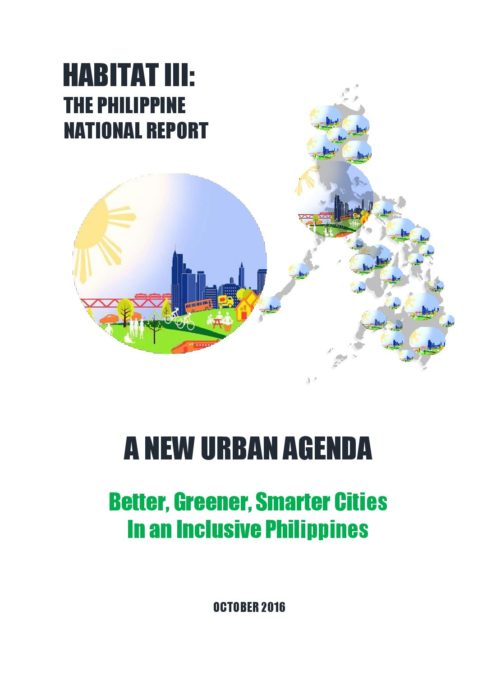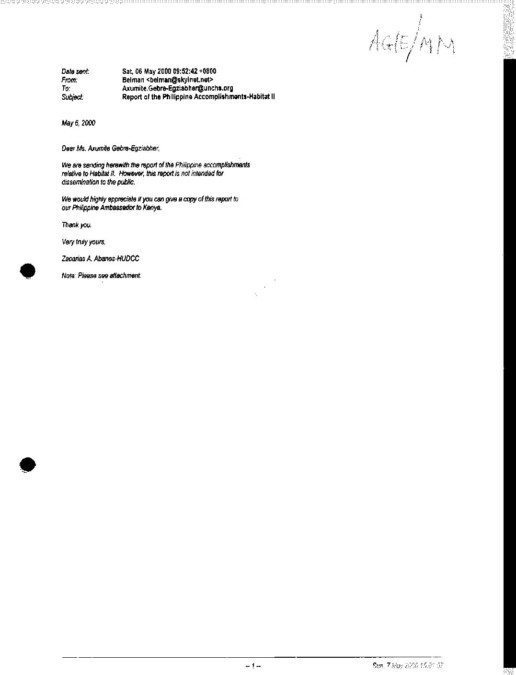
Philippines
Urban indicators:
| Value | Year | ||
| Surface area (sq km) | 300000 | 2014 | |
| Population (proj., 000) | 102250 | 2016 | |
| Pop. density (per sq km) | 342.9 | 2016 | |
| Capital city | Manila | 2015 | |
| Capital city pop. (000) | 12946 | 2015 | Refers to the National Capital Region. |
| Population growth rate (average annual %) | 1.6 | 2010-2015 | |
| Urban population growth rate (average annual %) | 1.3 | 2010-2015 | |
| CO2 emission estimates (000 tons/tons per capita) | 98239/1.0 | 2013 | |
| Population using improved drinking water sources (urban/rural, %) | 93.7/90.3 | 2015 | |
| Population using improved sanitation facilities (urban/rural, %) | 77.9/70.8 | 2015 |
| 1995 | 2005 | 2014/2015 | |
| Urban population ('000) | 33,613 | 39,995 | 45,173 |
| Level of urbanization (%) | 48.3 | 46.6 | 44.4 |
| Proportion of urban population living in slum areas (%) | 50.8 | 43.7 | 38.3 |
| Urban Slum Population ('000) | 17,158 | 17,972 | 17,055 |
| Value | Year | |
| Urban Gini Coefficient | 0.45 | 2003i |
| Urban poverty headcount ratio based on national poverty lines | 13.0% | 2012 |
National Report:
National Report Executive Summary:
In 1996, the Philippines participated in the Second World Conference on Human Settlements or Habitat II. Held in Istanbul, Turkey, the conference addressed two themes of equal global importance: Adequate Shelter for All and Sustainable Human Settlements Development in an Urbanizing World. As an active member of the United Nations Center for Human Settlements, now known as UN-Habitat, the Philippines presented its national report entitled Shelter And Human Settlements: Philippine Report and Plan of Action at the conference. The national report contained the country's 20-year urban development roadmap which was anchored on three interconnected strategies: total human development, global competitiveness and sustainable development. It also contained the country’s commitments which focused on infrastructure development in support of human settlements, pursuit of knowledge and livelihood, and ensuring physical, economic and social mobility. Twenty years later and the Philippines appears to have made significant achievements against most of its commitments under Habitat II.
Over the years, however, it has likewise emerged as one of the most populous countries in the world, with a population of over 100 million. The country's rapid urbanization has put tremendous pressures on city governments' to provide affordable, reliable, and quality basic urban services. The urban reach of Metro Manila—which has transformed into a megacity—has also expanded to the nearby regions as a result of sustained economic growth, making it one of the most populous urban agglomerations in the world. The country's population is predominantly young, with the share of population below 30 years old at around 60%. With this the country faces a demographic window of opportunity from youth dividends which could potentially sustain an annual growth rate of at least 7%. To address this, several initiatives have been launched. The Enhanced Basic Education Act extends formal education from 10 to 12 years in order to harness the county’s young and trainable pool of human resources. The Alternative Learning System provides a chance to those who do are unable to do so to attend and finish formal basic education. The Youth Education-Youth Employment Program responds to the needs of the disadvantaged youth. The Youth Entrepreneurship Act provides young people with business acumen by introducing entrepreneurship and finance in the education curriculum. Building the capacity and life skills of its people, particularly the youth, for how to become productive members of a fast modernizing urban economy will be a key challenge of the Philippines in the coming years.
The country's archipelagic nature and geographic location have made it highly vulnerable to the adverse impacts of climate change and environmental degradation. Climate change in the Philippines has been acutely felt in the last ten years through increased temperature, precipitation, rainfall, drought, flooding, storm surges, rising sea level, limited water supply, forest fires, and other changing weather patterns. Metro Manila is at high risk from cyclones, floods, and earthquakes. Metro Davao, the largest urban agglomeration in the island of Mindanao, is also exposed to the same risks. Cebu, Tacloban, and Iloilo in the Visayas have likewise sustained tremendous damages from major earthquakes and super typhoons these past years. National and local governments have made significant strides in mainstreaming climate change action (CCA) and disaster risk reduction and management (DRRM) in their city development and comprehensive land use planning. Emerging good practices in CCA and DRRM are being monitored, distilled, and developed as tools for quick application by local governments and communities. But challenges remain in institutionalizing policies, systems, and procedures and in making sure the coordination mechanisms among all stakeholders work.
Together, the 1991 Local Government Code (LGC) of the Philippines and the Urban Development and Housing Act (UDHA) of 1992 mandate the preparation of a Comprehensive Land Use Plan (CLUP) and a Comprehensive Development Plan (CDP) by local governments. Guidebooks and sourcebooks are available and regularly updated for the use of local governments in the preparation of their CLUPs and CDPs. They streamline the planning process, integrate environmental guidelines, facilitate cross-sectoral integration, standardize the formats used, and incorporate CCA and DRRM. However, the urban sprawl in the Philippines has become evident, caused mainly by the search for cheaper land outside the metropolises and the weak implementation of local plans and zonal ordinances. Many local governments lack the capacity to properly guide the direction of urban expansion. Transport networks and utility service extensions have been used more to service developments already in place than to shape and influence the direction of development. Open spaces for public use are not being protected sufficiently for the public. Sidewalks, even traffic islands, are being appropriated for private use, particularly in highly urbanized cities. Waterfronts, coastal zones, mountain ridges, and other visual corridors that offer excellent views of landscapes and seascapes have been built over, blocking the public view. Even some heritage sites are not being spared. Urban-rural linkages, particularly to fuel more economic activities and enhance urban as well as peri-urban food production, have yet to be more carefully considered.
Urban governance in the Philippines involves a number of institutions, resulting in complex vertical-horizontal institutional coordination and linkages for planning, implementation, and operation of infrastructure and services. Although the decentralization process can be deemed a success, the nature of the urban challenges currently confronting Philippine cities calls for some changes, particularly for regional and large-scale infrastructure projects involving inter-jurisdictional cooperation. There have been watershed urban legislations, particularly the LGC and the UDHA which continue to be highly relevant for enabling sector investments, programs, and projects. Several measures have also been adopted for improved urban governance, including the Local Government Performance Management System and the Seal of Good Local Governance. These help measure the effectiveness and efficiency of local governance and promote transparency, accountability, financial management, disaster preparedness, social protection, business friendliness, peace and order, and environmental management.
But the accelerated pace of urbanization in the Philippines, with its archipelagic nature and geographic location making it highly vulnerable to climate change, calls for some modifications to the existing urban governance framework. Strengthening urban sector leadership, addressing the urban legal gaps, and fine tuning the decentralized urban service delivery framework are priorities for the coming years. Transparency and accountability through digital governance are also vital. Participatory mechanisms in the Philippines have become noteworthy, especially those involving NGOs and other civil society organizations. Given the complexity of the evolving urban challenges, however, they need to become even more innovative, aimed at more meaningful placemaking and public space design, leading to neighborhood livability and the public's wellbeing.
Philippine cities, particularly Metro Manila and other highly urbanized cities, have helped to propel the overall urban economy, which in turn has spurred the country's sustained economic expansion. However, many of them are still confronted by a multitude of urban problems such as congestion, overcrowding, poor quality of life, and rapidly growing poor urban communities. There is deficient investment in urban infrastructure—mostly for housing, water supply and sanitation, solid waste management, and low-carbon yielding urban transport. Moreover, unemployment and underemployment persists despite the sustained expansion of the overall economy and its record growth record of late. The highest incidences of unemployment in the country are seen among males, workers with higher educational attainment, and the youth. Meanwhile, underemployment is highest in the agriculture-based regions and in regions more vulnerable to climate change. The combined unemployment and underemployment rates account for the high poverty incidence that lingers in the country. Growth has, therefore, not been inclusive so far. More and better jobs, as well as equal access to improved livelihood opportunities are needed. The fast-growing sectors of the economy, including micro, small, and medium enterprises (MSMEs) should be fully supported.
The delivery of safe water, sanitation, waste management, energy, and transport continues to be a major challenge in the Philippines, particularly with respect to creating the conditions necessary for livability and resiliency in the cities. The strategies to be employed must consider economies of scale—which in many cases can be achieved by a more spatially integrated and regionally balanced approach—as well as sustained private sector participation. Climate change also imposes the inclusion of more "green" features. Investments can be more rationalized using a co-benefit approach which espouses that projects to be considered must have multiple benefits in different sectors resulting from one policy, strategy, or initiative.
On the housing front, the current level of production represents a very small fraction of the estimated housing need—perpetuating the formation of informal settlements and slums in Metro Manila and other urban metropolis around the country. Informal settler families must be transformed and enabled to find secure and better places to live—in resilient communities that are able to withstand climate change and natural disasters, vibrant communities animated with socio-economic dynamism and quality urban infrastructure and services, and connected communities that are linked by transport and telecommunication to employment, sources of livelihood, the urban economy, and the rest of the city.
The country's archipelagic setting combined with the magnitude of urbanization makes accessibility between and within the islands costly and time consuming. The intense movement of people, materials and information, combined with generally inadequate urban transport systems in the Philippines, is causing millions in lost productivity and economic opportunities. There has been a bias so far towards planning for individual motorized transport rather than accessibility. This has led to tremendous traffic congestion and urban sprawl. The Avoid-Shift-Improve Framework is being promoted in planning subsequent urban transport systems. The envisioned outcome is a successful transition to a more inclusive, greener urban transport system with a lower carbon footprint for Metro Manila and other highly urbanized cities nationwide.
Against this background, the Philippine Government began its national report preparation for the Third World Conference on Human Settlements or Habitat III to be held in Quito, Ecuador on 17-20 October 2016. The New Urban Agenda was formulated using a consultative, participatory, and consensus building approach, entailing a series of thematic, regional, and multi-sectoral workshops. The theme of the New Urban Agenda is Better, Greener, Smarter Cities in an Inclusive Philippines—reflective of the aspirations of millions of Filipinos for the future of their cities. Better Cities are globally competitive, economically vibrant, and livable. Greener Cities are environmentally sustainable, climate resilient, and safe. Smarter Cities are connected, physically, spatially and digitally. An Inclusive Philippines is equitable, participatory, and provides universal access to quality basic services. It safeguards children, women, the elderly people, and persons with disability. It equalizes access to livelihood opportunities. And last but not least, it facilitates the transformation of informal settler families in the metropolises, enabling them to live their lives with more pride and dignity.
Statements by Philippines:
-
Habitat III Plenaries
Statements by other countries on behalf of G77 and China:
-
Habitat III Plenaries
-
Intersessionals: Informal Intergovernmental Meetings (May 2016)
- Statement - 18 May (by Thailand) - English Made by Thailand on Behalf of G77 and China
- Statement - 18 May (by Jamaica) - English Made by Jamaica on Behalf of G77 and China
- Statement - 19 May (by Jamaica) - English Made by Jamaica on Behalf of G77 and China
- Statement - 19 May (by Kenya) - English Made by Kenya on Behalf of G77 and China
- Statement - 20 May (by Jamaica) - English Made by Jamaica on Behalf of G77 and China
- Statement - 20 May (by Thailand) - English Made by Thailand on Behalf of G77 and China
We thank the Philippines for co-facilitating the informal intergovernmental negotiations on the outcome document of the Habitat III Conferece - the New Urban Agenda.



